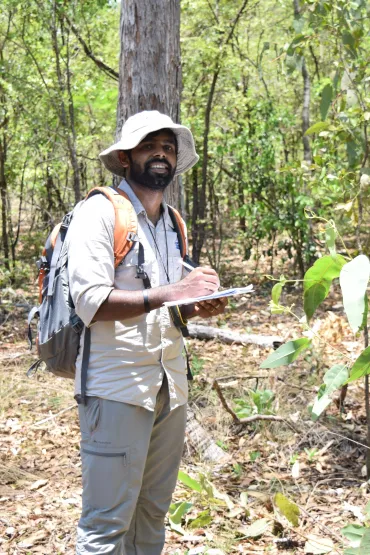Research project title
The role of competition in shaping Australia’s tropical savannas
Abstract
The structure and function of savannas are driven by the availability of resources, such as water and nutrients, as well as disturbance regimes, such as frequent fires. There is no general consensus as to how these drivers interact and both lifeforms interact negatively (competition) or positively (facilitation) in time and space. Northern Australian savannas are amongst the most fire-prone biomes on Earth and, as a result, are dominated by eucalypts (Eucalyptus and Corymbia spp.). It is not clear what processes allow this group to dominate under such extreme fire frequencies, and if nutrient availability and resource competition, drive tree population dynamics. This research helps address knowledge gaps in understanding the role of nutrients and plant competition in structuring tree populations in Australian tropical savannas.
This research examined (i) the importance of resources to tree seedling establishment and growth; (ii) spatial patterns of trees under different fire regimes in a long-term fire experiment; (iii) competition among grass and tree species with an increasing density of neighbour plants; and (iv) responses of juvenile tree species to the removal of belowground root competition in fire excluded savannas. Across these analyses, growth responses were analysed by two main eco-taxonomical tree functional groups, eucalypt versus non-eucalypt tree species.
The results show that, the nutrients are a major determinant of tree growth and establishment in northern Australian savannas. Eucalypts showed a rapid height growth when compared to non-eucalypts once seasonal nutrient limitations were removed, which increased their likelihood of escaping the fire trap. Fire intensity was a major driver of tree spatial distribution in these savannas with a random distribution of trees in the high-intensity fires and clustered pattern in the low-intensity fires and fire exclusion. Distribution of eucalypts were spatially random versus a clustered pattern for non-eucalypts. However, the clustered pattern of non-eucalypts was driven by juvenile trees (2–4 m high) which may be explained by dispersal mediated establishment patterns of non-eucalypts and increasing rates of resource competition. These findings were confirmed by shade-house experiments, which provided evidence for strong tree–grass and tree–tree competitive interactions, with growth of non-eucalypt seedlings impacted the most from competition pressure. However, at a stage of height (juveniles) where, tree species are able to escape fire trap, competition for below-ground resources has a limited role and other drivers such as fire and competition for light may affect tree growth. This research suggests that, changes in fire regimes through prescribed burning and fire exclusion may lead to woody thickening due greater establishment success of non-eucalypts under low fire frequencies.
Research interests
Dr Harinandanan Paramjyothi is an alumnus of the Research Institute for the Environment and Livelihoods (RIEL). His PhD supervisors were Dr. Brett Murphy, Prof. Lindsay Hutley, Dr. Anna Richards (CSIRO) and Prof. Jeremy Russell-Smith. He investigated the role of competition in shaping northern Australian savannas and the long-term responses of tree populations to fire management. Prior to his PhD research, Hari worked as a research fellow at the National Centre for Biological Sciences, India with most of his work focusing on the tree–grass dynamics in the tropical biomes of India and distribution patterns of grass species in the Indian sub-continent. Hari holds a Bachelor's in Botany from the Calicut University, India and a Master's in Plant Biotechnology from the Mahatma Gandhi University, India.
